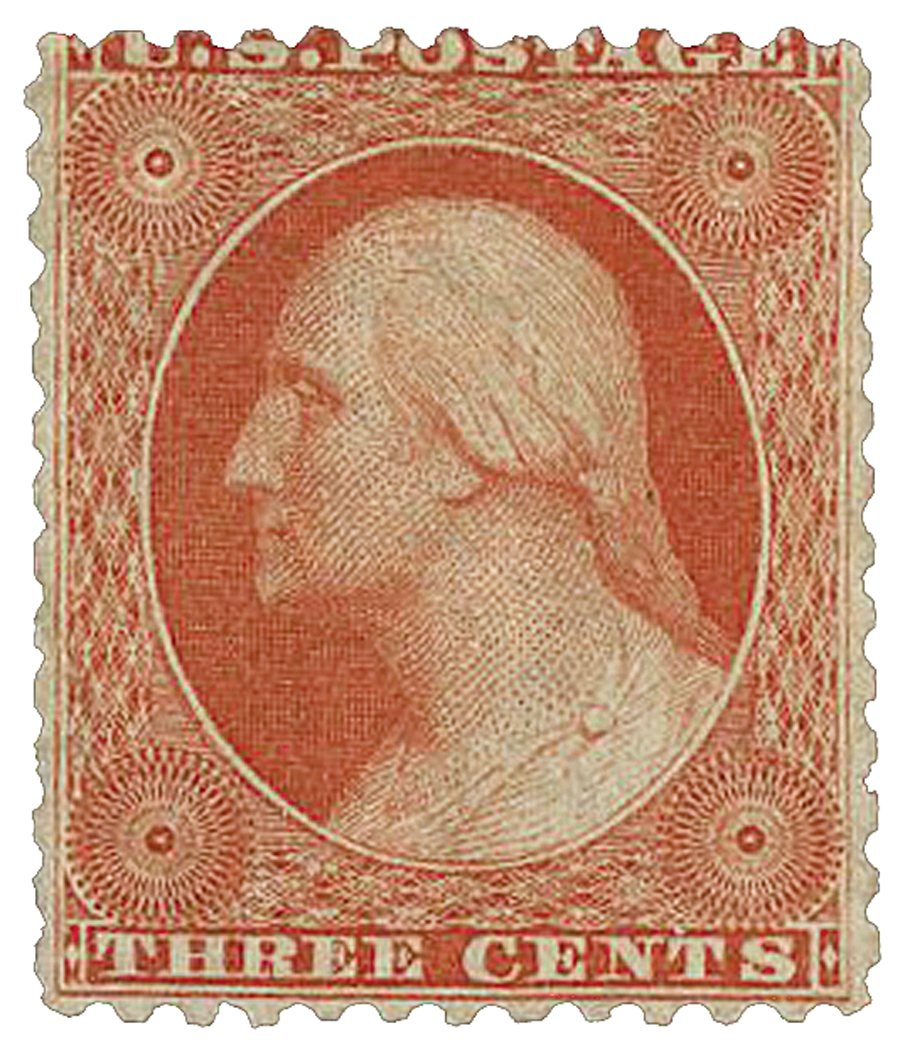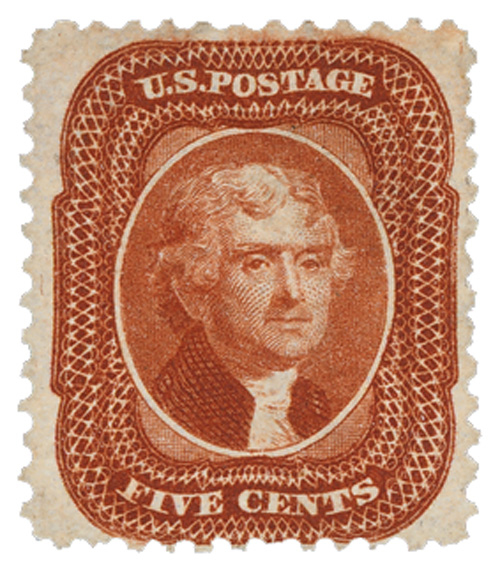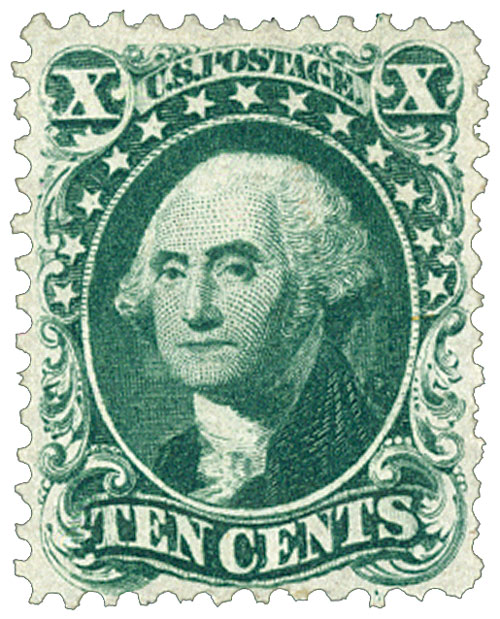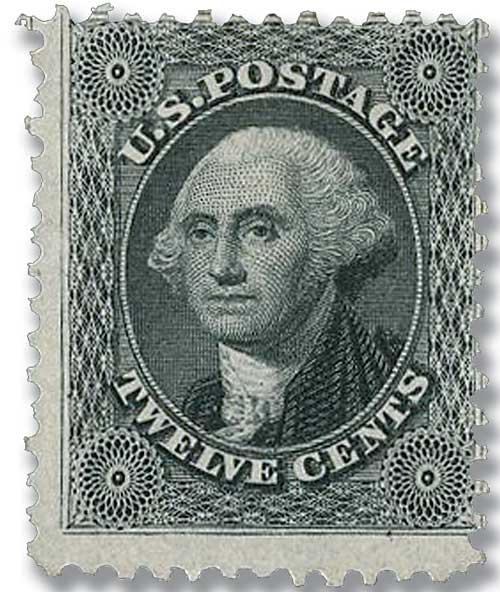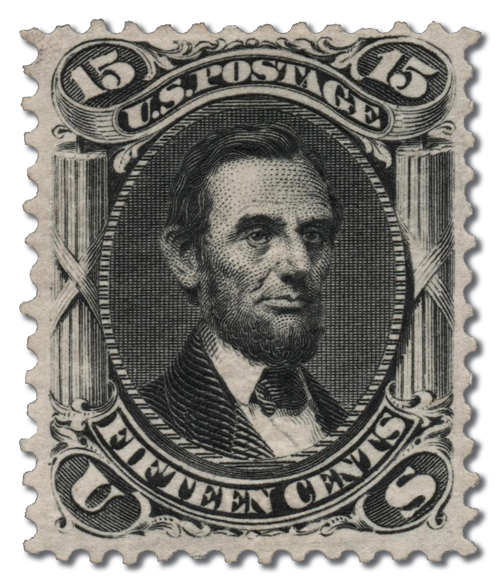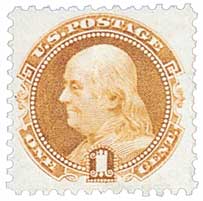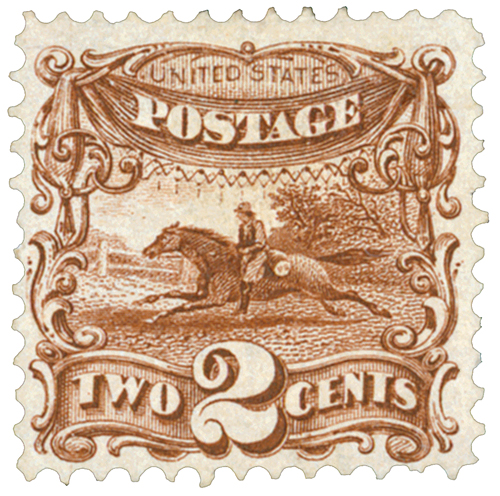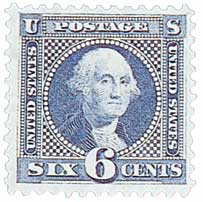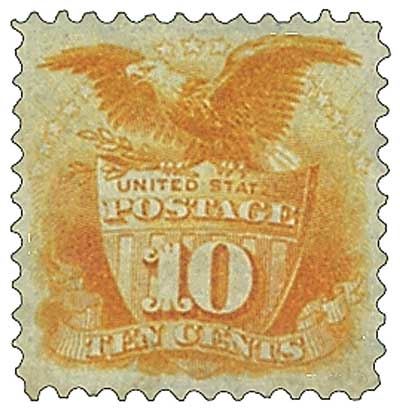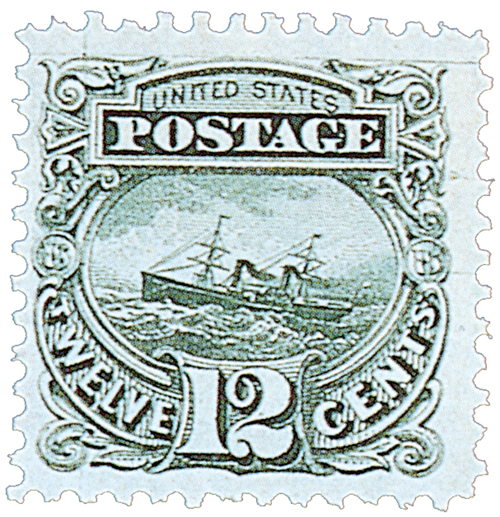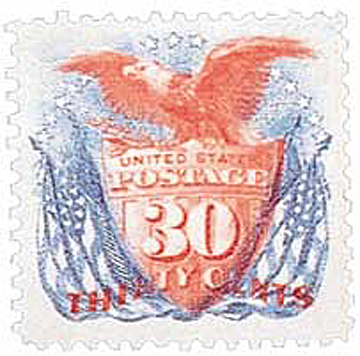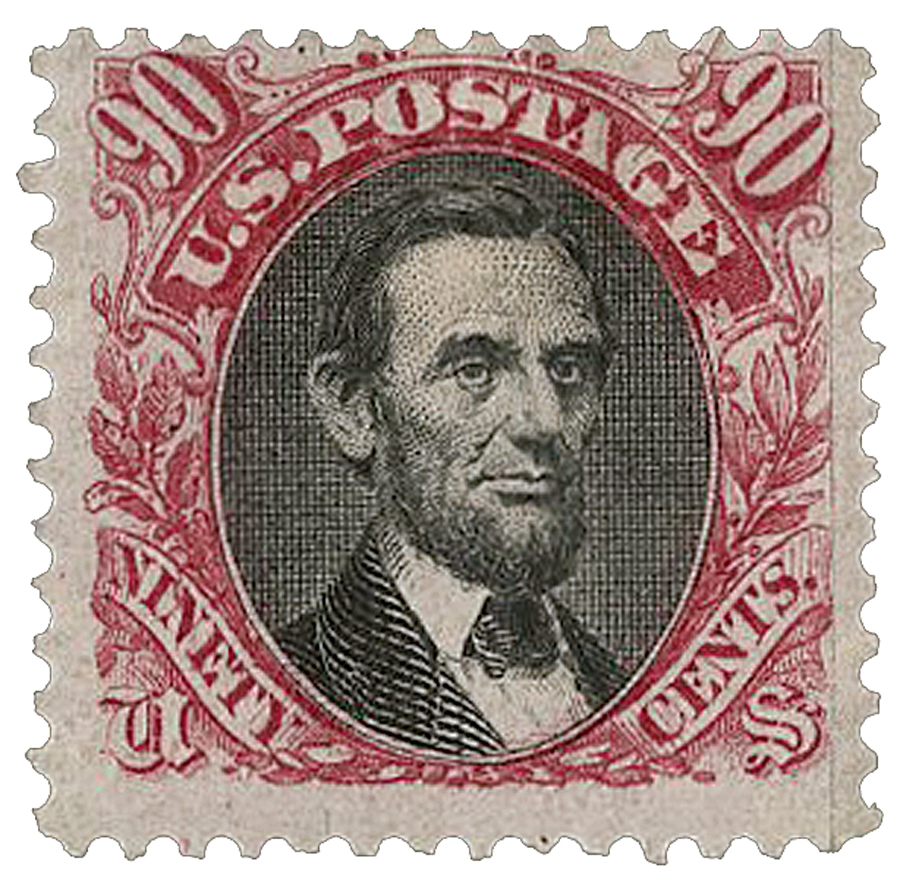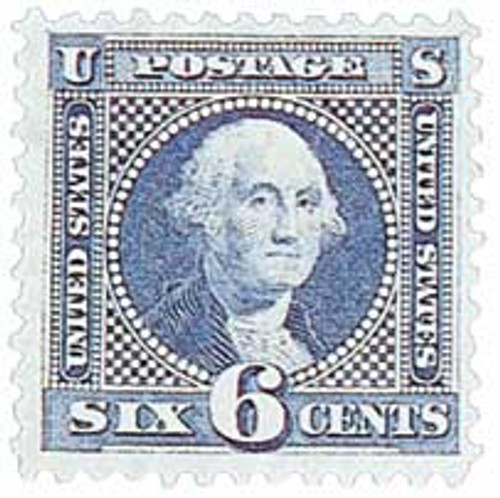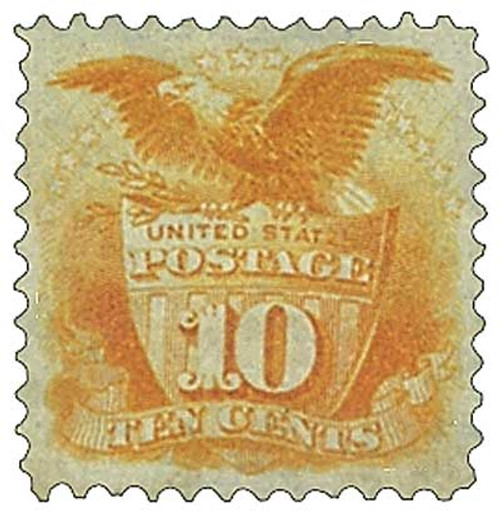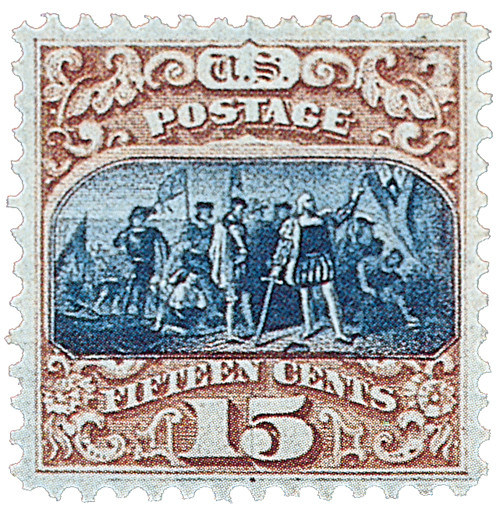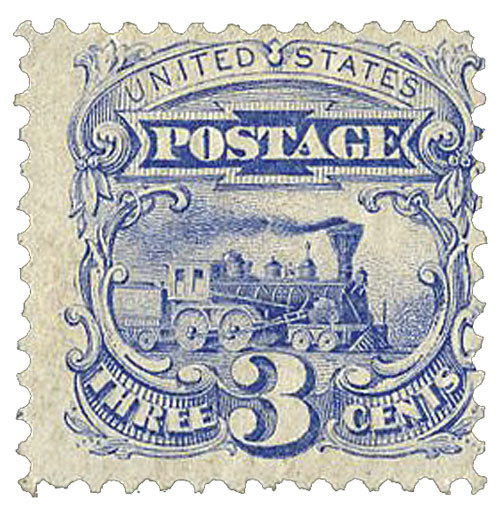
# 132 - 1875 90c Lincoln, carmine and black
U.S. #132
1875 90¢ Lincoln
1875 Re-Issue of 1869 Issue
Issue date: 1875
Quantity sold: 1,356
Printed by: National Bank Note Company
Method: Flat plate
Watermark: None
Perforation: 12
Color: Carmine and Black
As the nation’s centennial approached, organizers began planning a grand celebration in Philadelphia. It would be the first World’s Fair to be held in the United States. To commemorate the event, the Post Office Department reproduced all US postal issues for display and sale at the Centennial Exhibition.
Originally produced with a “G” grill, the 1869 Pictorial designs were reissued in 1875 without grills. The reissues were not sold at regular stamp windows, but were made for a Post Office Department display at the 1876 Centennial Exposition. Sets were sold directly to collectors by the Post Office Department in Washington, DC.
The National Bank Note Company produced the reprints in 1875. They are on hard white paper, and feature crackly white gum. A new plate of 150 subjects was made for the 1¢ and for the frame of the 15¢. The frame on the 15¢ is the same as type I but without the fringe of brown shading lines around the central vignette.
Centennial International Exhibition
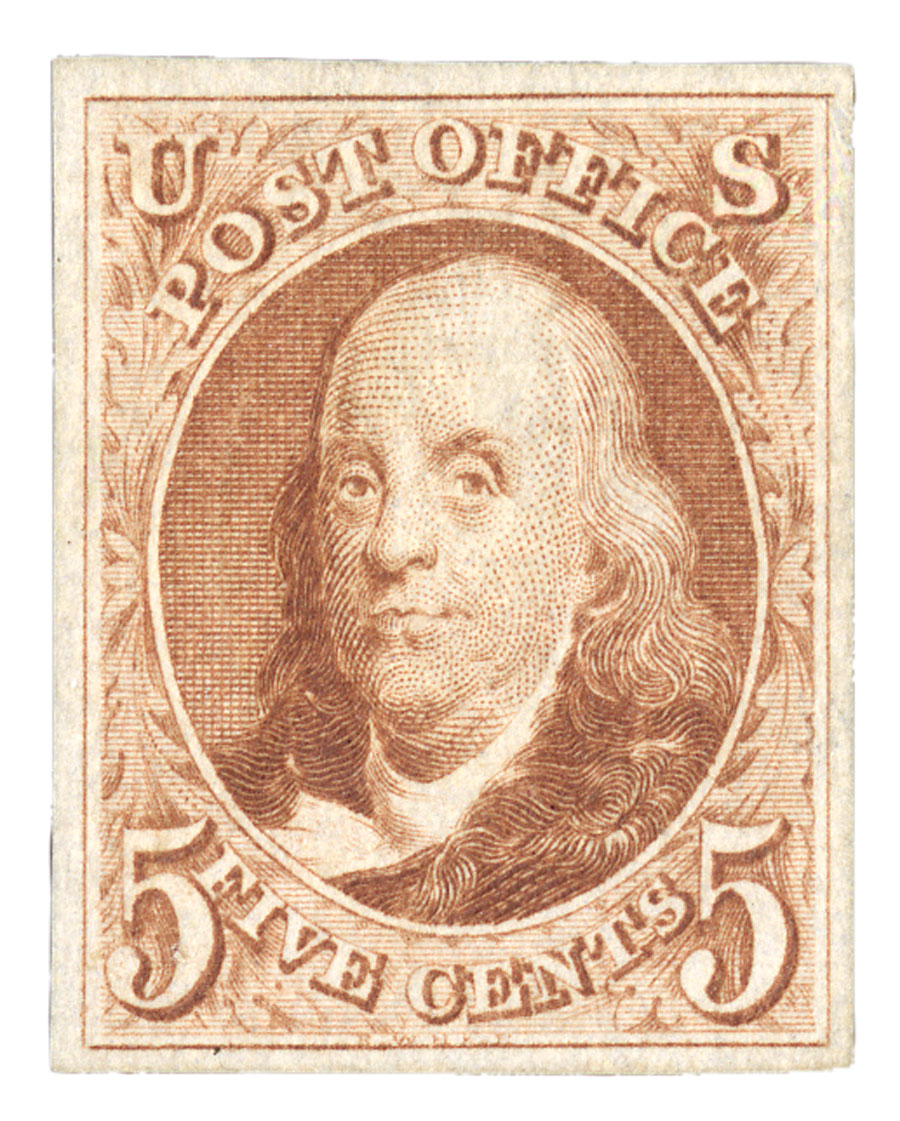
On May 10, 1876, the first official World’s Fair in the United States was held in Philadelphia, Pennsylvania. The fair also commemorated the 100th anniversary of the signing of the Declaration of Independence.
Prior to this, the U.S. had staged the Great Central Fair of 1864, one of several sanitary fairs held during the Civil War. This and similar fairs showed how public, private, and commercial efforts could join together for a larger fair. The 1864 fair included handmade and industrial exhibits and a visit from the president and his family and offered ordinary citizens the chance to support the welfare of Union soldiers and join in the war effort.
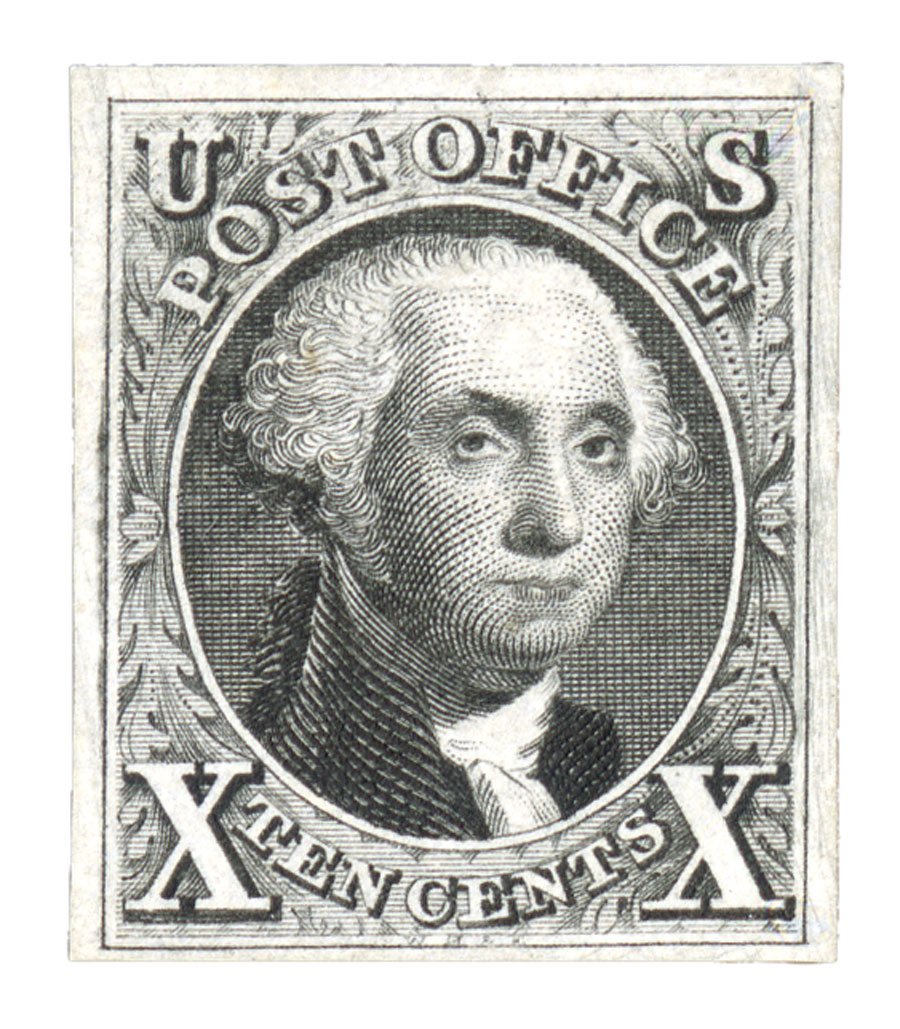
Two years after that fair, John L. Campbell, a professor at Wabash College, first suggested a world’s fair in Philadelphia to mark America’s centennial. Initially, many people thought it was a bad idea. They believed that they wouldn’t be able to find funding and that America’s exhibits might not measure up to those of foreign nations. With support from the Franklin Institute, though, the fair was approved in January 1870.
Funding came from several sources – the city, the state, and extensive fund raising. New hotels were built and transportation was improved to bring people into and around Philadelphia. The 115-acre fairgrounds housed more than 200 buildings. These included five main buildings as well as separate structures for state, federal, foreign, corporate, and public exhibits. This was an unusual strategy compared to past fairs that usually only had one or a few large buildings.

The fair’s formal name was “The International Exhibition of Arts, Manufactures, and Products of the Soil and Mine,” but it was more commonly known as the Centennial Exhibition. It was originally supposed to open in April, to honor the battle of Lexington and Concord, but it had to be delayed due to construction issues. The fair finally opened on May 10, 1876, with the ringing of bells throughout Philadelphia. President Ulysses S. Grant, Emperor Pedro II of Brazil and their wives participated in the opening ceremonies. Grant and Pedro ended the ceremony by turning on the Corliss Steam Engine that powered many of the exposition’s machines.
That first day, 186,272 people were in attendance, though 110,000 had free passes. Attendance dropped off sharply after that, and was further hurt by a heat wave in June and July. Cooling temperatures and positive reviews later created a surge in attendance.
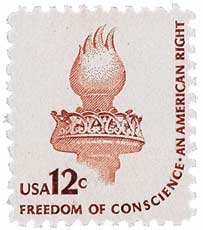
Visitors to the fair saw a number of new inventions, including sewing machines, typewriters, stoves, air-powered tools, lanterns, guns, horse-drawn wagons, carriages, and an array of agricultural equipment. Among the most popular exhibits were the world’s first monorail system and a portion of the Statue of Liberty (its arm and torch). Visitors could pay 50¢ to climb a ladder to the top of the torch. These funds were used to help pay for the statue’s pedestal. Additionally, Alexander Graham Bell’s telephone was set up at opposite ends of one hall to show how voice could travel over wires. And Thomas Edison displayed his Automatic telegraph system and electric pen. Visitors were also introduced to some new foods, including bananas, popcorn, and Heinz ketchup.
The U.S. Post Office Department also had a strong presence at the fair. They wanted to sell every U.S. stamp at the exhibition, even those that were no longer in use. Because many of the original plates couldn’t be found, new ones had to be engraved. Observant collectors noticed subtle differences, so Scott gave them their own numbers. Not realizing they had created philatelic rarities, the Post Office Department sold them as planned. Most of these stamps weren’t valid for postage and were issued in very small quantities. And most of the unsold stamps were later destroyed!

While the fair didn’t turn a significant profit, 10 million people attended it. Additionally, it showed other nations how much America had grown industrially and commercially and helped to increase trade.
See below for more of the stamps issued at the exhibition. They were all produced in limited quantities!
Click here for images and more from the exhibition.
U.S. #132
1875 90¢ Lincoln
1875 Re-Issue of 1869 Issue
Issue date: 1875
Quantity sold: 1,356
Printed by: National Bank Note Company
Method: Flat plate
Watermark: None
Perforation: 12
Color: Carmine and Black
As the nation’s centennial approached, organizers began planning a grand celebration in Philadelphia. It would be the first World’s Fair to be held in the United States. To commemorate the event, the Post Office Department reproduced all US postal issues for display and sale at the Centennial Exhibition.
Originally produced with a “G” grill, the 1869 Pictorial designs were reissued in 1875 without grills. The reissues were not sold at regular stamp windows, but were made for a Post Office Department display at the 1876 Centennial Exposition. Sets were sold directly to collectors by the Post Office Department in Washington, DC.
The National Bank Note Company produced the reprints in 1875. They are on hard white paper, and feature crackly white gum. A new plate of 150 subjects was made for the 1¢ and for the frame of the 15¢. The frame on the 15¢ is the same as type I but without the fringe of brown shading lines around the central vignette.
Centennial International Exhibition

On May 10, 1876, the first official World’s Fair in the United States was held in Philadelphia, Pennsylvania. The fair also commemorated the 100th anniversary of the signing of the Declaration of Independence.
Prior to this, the U.S. had staged the Great Central Fair of 1864, one of several sanitary fairs held during the Civil War. This and similar fairs showed how public, private, and commercial efforts could join together for a larger fair. The 1864 fair included handmade and industrial exhibits and a visit from the president and his family and offered ordinary citizens the chance to support the welfare of Union soldiers and join in the war effort.

Two years after that fair, John L. Campbell, a professor at Wabash College, first suggested a world’s fair in Philadelphia to mark America’s centennial. Initially, many people thought it was a bad idea. They believed that they wouldn’t be able to find funding and that America’s exhibits might not measure up to those of foreign nations. With support from the Franklin Institute, though, the fair was approved in January 1870.
Funding came from several sources – the city, the state, and extensive fund raising. New hotels were built and transportation was improved to bring people into and around Philadelphia. The 115-acre fairgrounds housed more than 200 buildings. These included five main buildings as well as separate structures for state, federal, foreign, corporate, and public exhibits. This was an unusual strategy compared to past fairs that usually only had one or a few large buildings.

The fair’s formal name was “The International Exhibition of Arts, Manufactures, and Products of the Soil and Mine,” but it was more commonly known as the Centennial Exhibition. It was originally supposed to open in April, to honor the battle of Lexington and Concord, but it had to be delayed due to construction issues. The fair finally opened on May 10, 1876, with the ringing of bells throughout Philadelphia. President Ulysses S. Grant, Emperor Pedro II of Brazil and their wives participated in the opening ceremonies. Grant and Pedro ended the ceremony by turning on the Corliss Steam Engine that powered many of the exposition’s machines.
That first day, 186,272 people were in attendance, though 110,000 had free passes. Attendance dropped off sharply after that, and was further hurt by a heat wave in June and July. Cooling temperatures and positive reviews later created a surge in attendance.

Visitors to the fair saw a number of new inventions, including sewing machines, typewriters, stoves, air-powered tools, lanterns, guns, horse-drawn wagons, carriages, and an array of agricultural equipment. Among the most popular exhibits were the world’s first monorail system and a portion of the Statue of Liberty (its arm and torch). Visitors could pay 50¢ to climb a ladder to the top of the torch. These funds were used to help pay for the statue’s pedestal. Additionally, Alexander Graham Bell’s telephone was set up at opposite ends of one hall to show how voice could travel over wires. And Thomas Edison displayed his Automatic telegraph system and electric pen. Visitors were also introduced to some new foods, including bananas, popcorn, and Heinz ketchup.
The U.S. Post Office Department also had a strong presence at the fair. They wanted to sell every U.S. stamp at the exhibition, even those that were no longer in use. Because many of the original plates couldn’t be found, new ones had to be engraved. Observant collectors noticed subtle differences, so Scott gave them their own numbers. Not realizing they had created philatelic rarities, the Post Office Department sold them as planned. Most of these stamps weren’t valid for postage and were issued in very small quantities. And most of the unsold stamps were later destroyed!

While the fair didn’t turn a significant profit, 10 million people attended it. Additionally, it showed other nations how much America had grown industrially and commercially and helped to increase trade.
See below for more of the stamps issued at the exhibition. They were all produced in limited quantities!
Click here for images and more from the exhibition.





